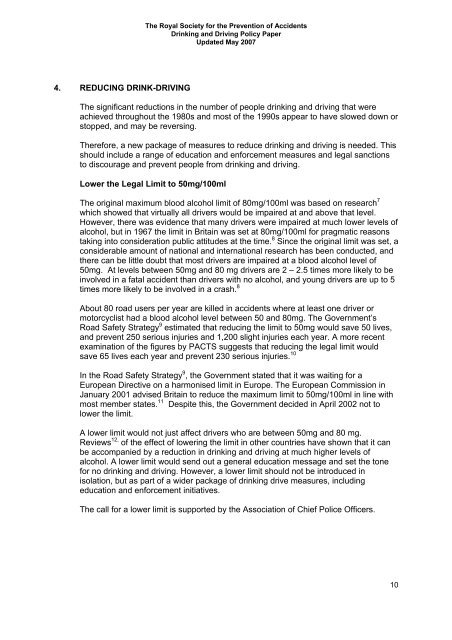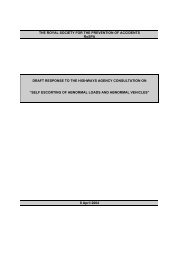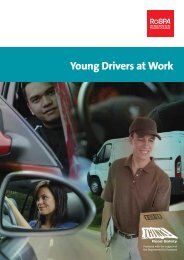RoSPA Drinking and Driving Policy Paper 2007
RoSPA Drinking and Driving Policy Paper 2007
RoSPA Drinking and Driving Policy Paper 2007
Create successful ePaper yourself
Turn your PDF publications into a flip-book with our unique Google optimized e-Paper software.
The Royal Society for the Prevention of Accidents<br />
<strong>Drinking</strong> <strong>and</strong> <strong>Driving</strong> <strong>Policy</strong> <strong>Paper</strong><br />
Updated May <strong>2007</strong><br />
4. REDUCING DRINK-DRIVING<br />
The significant reductions in the number of people drinking <strong>and</strong> driving that were<br />
achieved throughout the 1980s <strong>and</strong> most of the 1990s appear to have slowed down or<br />
stopped, <strong>and</strong> may be reversing.<br />
Therefore, a new package of measures to reduce drinking <strong>and</strong> driving is needed. This<br />
should include a range of education <strong>and</strong> enforcement measures <strong>and</strong> legal sanctions<br />
to discourage <strong>and</strong> prevent people from drinking <strong>and</strong> driving.<br />
Lower the Legal Limit to 50mg/100ml<br />
The original maximum blood alcohol limit of 80mg/100ml was based on research 7<br />
which showed that virtually all drivers would be impaired at <strong>and</strong> above that level.<br />
However, there was evidence that many drivers were impaired at much lower levels of<br />
alcohol, but in 1967 the limit in Britain was set at 80mg/100ml for pragmatic reasons<br />
taking into consideration public attitudes at the time. 8 Since the original limit was set, a<br />
considerable amount of national <strong>and</strong> international research has been conducted, <strong>and</strong><br />
there can be little doubt that most drivers are impaired at a blood alcohol level of<br />
50mg. At levels between 50mg <strong>and</strong> 80 mg drivers are 2 – 2.5 times more likely to be<br />
involved in a fatal accident than drivers with no alcohol, <strong>and</strong> young drivers are up to 5<br />
times more likely to be involved in a crash. 8<br />
About 80 road users per year are killed in accidents where at least one driver or<br />
motorcyclist had a blood alcohol level between 50 <strong>and</strong> 80mg. The Government’s<br />
Road Safety Strategy 9 estimated that reducing the limit to 50mg would save 50 lives,<br />
<strong>and</strong> prevent 250 serious injuries <strong>and</strong> 1,200 slight injuries each year. A more recent<br />
examination of the figures by PACTS suggests that reducing the legal limit would<br />
save 65 lives each year <strong>and</strong> prevent 230 serious injuries. 10<br />
In the Road Safety Strategy 9 , the Government stated that it was waiting for a<br />
European Directive on a harmonised limit in Europe. The European Commission in<br />
January 2001 advised Britain to reduce the maximum limit to 50mg/100ml in line with<br />
most member states. 11 Despite this, the Government decided in April 2002 not to<br />
lower the limit.<br />
A lower limit would not just affect drivers who are between 50mg <strong>and</strong> 80 mg.<br />
Reviews 12, of the effect of lowering the limit in other countries have shown that it can<br />
be accompanied by a reduction in drinking <strong>and</strong> driving at much higher levels of<br />
alcohol. A lower limit would send out a general education message <strong>and</strong> set the tone<br />
for no drinking <strong>and</strong> driving. However, a lower limit should not be introduced in<br />
isolation, but as part of a wider package of drinking drive measures, including<br />
education <strong>and</strong> enforcement initiatives.<br />
The call for a lower limit is supported by the Association of Chief Police Officers.<br />
10
















